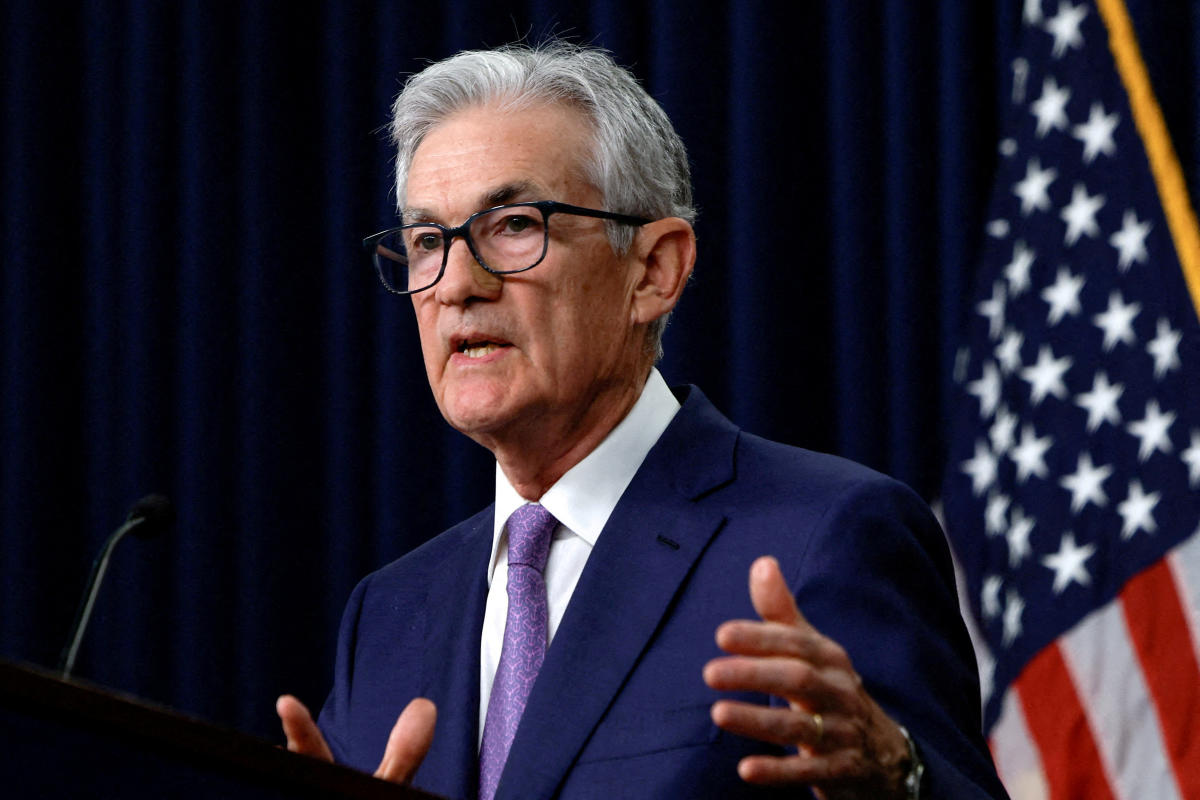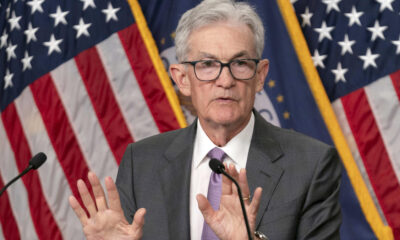News
Why the Fed’s first rate cut wouldn’t be that big of a deal

A version of this post first appeared on TKer.co
The calls for the Federal Reserve to begin cutting interest rates sooner than later have been getting louder.
The resistance to these calls seems to be the suggestion that an initial rate cut would represent some monumental dovish shift in monetary policy at a time when concerns about inflation haven’t been fully put to rest.
But it’s not obvious to me that one rate cut is so big of a deal that it warrants some extraordinarily high hurdle for it to happen, especially with economic activity trends cooling.
‘Get on with it’
Inflation metrics have been coming down for two years and are now at levels that are just a rounding error away from the Fed’s 2% target rate.
Meanwhile, economic activity growth has been decelerating significantly, with labor market metrics normalizing. The economy has been looking a lot less “coiled,” with many signs of excess demand fading.
“Previously, with inflation far from its objective and employment closer to its objective, the Fed’s focus was on inflation,” BofA’s Michael Gapen said on Thursday. “Now, with smaller deviations in inflation and employment from target, the Fed’s attention can be more balanced. Cuts can happen because the economy cools, because inflation slows, or both.”
The risk of recession has been rising with economic growth slowing. Consumer spending growth plateauing and debt delinquencies rising are among the emerging warning signs. Notably, the unemployment rate has been ticking higher.
Taken altogether, it’s not surprising to hear Fed watchers argue for a rate cut.
“Get on with it,” says Renaissance Macro’s Neil Dutta, who has been out front among his peers with this call.
The Fed’s Federal Open Market Committee (FOMC) meets for its monetary policy meeting this coming Tuesday and Wednesday. While it’s unlikely that the central bank will announce a rate cut at the conclusion of this meeting, it may use it to signal future changes in policy.
“The Fed is getting closer to begin recalibrating monetary policy,” Dutta wrote in a note to clients on Monday. “Recent commentary strongly point to a September rate cut with July’s meeting being used to prep the markets that a series of cuts are on the horizon.”
Dutta isn’t alone in his call for the Fed to begin cutting rates soon.
“Markets are almost fully priced for a cut at the September 17-18 FOMC meeting, which remains our baseline forecast,” Goldman Sachs’ Jan Hatzius said earlier this month. “But we see a solid rationale for cutting as early as the July 30-31 meeting.”
Story continues
Even former NY Fed President and longtime hawk Bill Dudley has made the case for a July rate cut.
“The Fed should cut, preferably at next week’s policy-making meeting,” Dudley wrote on Wednesday. “Although it might already be too late to fend off a recession by cutting rates, dawdling now unnecessarily increases the risk.”
While he hasn’t explicitly said anything about cutting rates in the coming months, Fed Chair Jerome Powell has recently acknowledged the growing risks to the economy.
“[I]n light of the progress made both in lowering inflation and in cooling the labor market over the past two years, elevated inflation is not the only risk we face,” Powell said in his testimony to Congress earlier this month. “Reducing policy restraint too late or too little could unduly weaken economic activity and employment.”

Chair of the Federal Reserve of the United States Jerome Powell speaks during a Senate Banking, Housing, and Urban Affairs Committee hearing on July 9, 2024 in Washington, DC. (Photo by Bonnie Cash/Getty Images) (Bonnie Cash via Getty Images)
Monetary policy is not a light switch
While a first rate cut is arguably a historic milestone in the Fed’s fight to end the inflation crisis, I’m not convinced it’s as explosive of a market event as some pundits imply.
“I don’t think monetary policy is a ‘light switch,’” Dutta explained on CNBC. “It’s not on or off. The Fed can be nimble and flexible.”
I like this characterization because it addresses a nuance ignored in many discussions about rate cuts.
And I’ll take Dutta’s analogy a step further and say monetary policy is a “dimmer switch.” If your lights are on full power and you dim them by 5%, they’re still pretty bright, right?
Now take the Fed’s 5.25% to 5.5% target range for rates and cut it by 25 basis points. You get a range of 5% to 5.25%. Sure, that would mean monetary policy is a little less tight. But it certainly can’t be characterized as loose monetary policy.
With inflation mostly under control and economic data deteriorating, what’s the harm in dimming monetary policy a little? There’s arguably more upside than downside.
Frankly, I think all the concerns about a first rate cut are overblown. As I argued in the January 28, TKer:
First of all, we’re talking about a potential 25-basis-point cut from a range of 5.25% to 5.5%. Sure, that’s not insignificant. But that’s nowhere near as big a deal as it was when we were talking about 25-, 50-, and 75-basis-point rate hikes from near 0%.
Second, all those big rate hikes early in the hike cycle were happening amid an intensifying inflation crisis. The economy was a complicated mess in 2022. Today, that crisis is largely behind us with inflation rates hovering near the Fed’s target levels…
In other words, the stakes for the upcoming Fed policy meetings aren’t nearly as high as they were in 2022 and 2023.
In March 2020, when the Fed cut rates by 150 basis points to effectively 0% as the economy was falling apart, that was a big deal.
Compared to monetary policy actions during more troubled times, cutting by just 25 basis points today just doesn’t seem like that big a deal.
Keeping historical context in mind, it may be advisable for the Fed to explicitly downplay the significance of a single rate cut and manage expectations for what a cut means for policy down the road.
“[W]e think Powell should and will avoid describing the first rate cut as consequential, as this conveys a sense of a series of rate cuts coming, which is the opposite of data dependent,” JPMorgan’s Michael Feroli wrote on Friday.
One rate cut may or may not bolster growth a little. It may or may not cause inflation to tick up a little. Who knows? But it’s hard to imagine a single rate cut going down in history as some massive policy blunder.
Zooming out
Maybe it’s the inevitable expectation that a first rate cut means that many more rate cuts are coming, and that’s what eventually moves inflation and other metrics in unfavorable ways. Well, then maybe the Fed will reverse course after the initial rate cut. As Dutta says, monetary policy is not a light switch, and the Fed has room to be nimble.
As far as the outlook for the stock market is concerned, history shows mixed results after an initial rate. Though, the 12-month price performance is less favorable when the Fed is cutting into a recession.
If the economy were to hold up following a first rate cut, then history suggests the outlook for stocks is positive.
Check out this chart from Ritholtz Wealth Management’s Callie Cox, which shows the 12-month performance of the S&P 500 following first rate cuts since 1970.
“It doesn’t look like we’re in a recession — or even close to one,” Cox wrote. “If history proves correct, we could see the stock market continue to move higher in a slow, grinding fashion.”
What the Fed does or doesn’t do in its upcoming policy meetings is sure to come with some kind of a market reaction. This can be said about most developments in the markets.
However, a 25-basis-point cut from a range of 5.25% to 5.5% seems pretty inconsequential relative to many of history’s other rate adjustments. And it would be a cut that comes as economic and financial market activity is relatively healthy.
TKer featured in Yahoo Finance Chartbook
The editors at Yahoo Finance invited me to submit a chart for their 2024 chartbook. My submission will look familiar to TKer subscribers.
Here’s what I said: “Schwab strategists made a great observation about the importance of staying invested. If you started with $10,000 in 1961 and invested in the S&P 500 only when there was a Republican in the White House, your investment would’ve grown to $102,000 in 2023. If you did the same but with a Democrat in the White House, that investment would’ve grown to $500,000. But none of that compares with the $5.1 million you would’ve had if you had stayed invested the whole time, regardless of who was president. It speaks to the power of compound interest and what can happen if you miss out on it.”
Check out the full Yahoo Finance chartbook
Reviewing the macro crosscurrents
There were a few notable data points and macroeconomic developments from last week to consider:
Inflation trends need to cool more. The personal consumption expenditures (PCE) price index in June was up 2.5% from a year ago, down from May’s 2.6% rate. The core PCE price index — the Federal Reserve’s preferred measure of inflation — was up 2.6% during the month, matching the lowest print since March 2021.
On a month over month basis, the core PCE price index was up 0.2%, up from 0.1% in the previous month. If you annualized the rolling three-month and six-month figures, the core PCE price index was up 2.3% and 3.4%, respectively.
Inflation rates have a little more to go to get to the Federal Reserve’s target rate of 2%, which is why the central bank continues to indicate that it wants more data before it is confident that inflation is under control. So even though there may not be more rate hikes and rate cuts may be around the corner, rates are likely to be kept high for a while.
Gas prices tick up. From AAA: “Barely budging since June, the national average for a gallon of gas squeaked out a two-penny increase to $3.52 since last week. The national average has hovered around $3.50 per gallon since June 26th.”
Consumers are spending. According to BEA data, personal consumption expenditures increased 0.3% month over month in June to a record annual rate of $19.44 trillion.
Adjusted for inflation, real personal consumption expenditures rose by 0.2%.
Card spending data is mixed. From JPMorgan: “As of 17 Jul 2024, our Chase Consumer Card spending data (unadjusted) was 2.2% below the same day last year. Based on the Chase Consumer Card data through 17 Jul 2024, our estimate of the U.S. Census July control measure of retail sales m/m is 0.20%.”
From Bank of America: “Total card spending per HH was down 0.3% y/y in week ending July 20, according to BAC aggregated credit & debit card data. Retail ex auto spending per HH came in at -0.8% y/y in week ending July 20. Online retail spending around Prime Day (including other retail promotions) appears to be tracking slightly ahead of 2023.”
Consumer sentiment worsens. From the University of Michigan’s July Surveys of Consumers: “Consumer sentiment has remained virtually unchanged in the last three months. July’s reading was a statistically insignificant 1.8 index points below June, well under the margin of error. Sentiment has lifted 33% above the June 2022 historic low, but it remains guarded as high prices continue to drag down attitudes, particularly for those with lower incomes. Labor market expectations remain relatively stable, providing continued support to consumer spending. However, continued election uncertainty is likely to generate volatility in economic attitudes in the months ahead.”
Unemployment claims fall. Initial claims for unemployment benefits declined to 235,000 during the week ending July 20, down from 245,000 the week prior. And while recent prints remain above the September 2022 low of 187,000, they continue to trend at levels historically associated with economic growth.
Mortgage rates tick higher. According to Freddie Mac, the average 30-year fixed-rate mortgage rose to 6.78% from 6.77% the week prior. From Freddie Mac: “Mortgage rates essentially remained flat from last week but have decreased nearly half a percent from their peak earlier this year. Despite these lower rates, buyers continue to pause, as reflected in tumbling new and existing home sales data.”
There are 146 million housing units in the U.S., of which 86 million are owner-occupied and 39% of which are mortgage-free. Of those carrying mortgage debt, almost all have fixed-rate mortgages, and most of those mortgages have rates that were locked in before rates surged from 2021 lows. All of this is to say: Most homeowners are not particularly sensitive to movements in home prices or mortgage rates.
Home sales fall. Sales of previously owned homes fell by 5.4% in June to an annualized rate of 3.9 million units. From NAR chief economist Lawrence Yun: “We’re seeing a slow shift from a seller’s market to a buyer’s market. Homes are sitting on the market a bit longer, and sellers are receiving fewer offers. More buyers are insisting on home inspections and appraisals, and inventory is definitively rising on a national basis.”
Home prices ticked higher. Prices for previously owned homes rose to record levels. From the NAR: “The median existing-home price for all housing types in June was $426,900, an all-time high and an increase of 4.1% from one year ago ($410,100). All four U.S. regions registered price gains.”
New home sales fall. Sales of newly built homes fell 0.6% in June to an annualized rate of 617,000 units.
Offices remain relatively empty. From Kastle Systems: “Occupancy Rises Across Cities After Weeks of Holiday and Weather Disruptions: The weekly average peak rose over five points to 61% on Tuesday this past week, as workers returned to the office in larger numbers after weeks of holiday and weather interruptions — especially throughout Texas. The weekly average low across all cities was Friday at 32.4% occupancy.:
Survey signals growth. From S&P Global’s July U.S. PMI: “The flash PMI data signal a ‘Goldilocks’ scenario at the start of the third quarter, with the economy growing at a robust pace while inflation moderates. Output across manufacturing and services is expanding at the strongest rate for over two years in July, the survey data indicative of GDP rising at an annualized rate of 2.5% after a 2.0% gain was signaled for the second quarter. The rate of increase of average prices charged for goods and services has meanwhile slowed further, dropping to a level consistent with the Fed’s 2% target.”
Keep in mind that during times of perceived stress, soft survey data tends to be more exaggerated than hard data.
Business investment activity is up. Orders for nondefense capital goods excluding aircraft — a.k.a. core capex or business investment — grew 1.0% to $73.99 billion in June.
Core capex orders are a leading indicator, meaning they foretell economic activity down the road. While the growth rate has leveled off a bit, they continue to signal economic strength in the months to come.
The economy grew nicely in Q2. According to preliminary Bureau of Economic Analysis data released on Thursday, U.S. GDP grew at an annual rate of 2.8% in Q2. This is up significantly from the 1.4% rate in Q1. Personal consumption grew at a healthy 2.3% rate.
Because the way GDP is calculated includes a lot of quirky metrics that distort the economic picture, economists will often point to “final sales to private domestic purchasers” to get a better sense of the underlying health of the economy. This metric excludes net exports, inventory adjustments, and government spending. That metric grew at a 2.6% rate in Q2, flat from the Q1 level.
Most U.S. states are still growing. From the Philly Fed’s June State Coincident Indexes report: “Over the past three months, the indexes increased in 40 states, decreased in eight states, and remained stable in two, for a three-month diffusion index of 64. Additionally, in the past month, the indexes increased in 35 states, decreased in 10 states, and remained stable in five, for a one-month diffusion index of 50.”
Near-term GDP growth estimates remain positive. The Atlanta Fed’s GDPNow model sees real GDP growth climbing at a 2.8% rate in Q3.
Putting it all together
We continue to get evidence that we are experiencing a bullish “Goldilocks” soft landing scenario where inflation cools to manageable levels without the economy having to sink into recession.
This comes as the Federal Reserve continues to employ very tight monetary policy in its ongoing effort to get inflation under control. While it’s true that the Fed has taken a less hawkish tone in 2023 and 2024 than in 2022, and that most economists agree that the final interest rate hike of the cycle has either already happened, inflation still has to stay cool for a little while before the central bank is comfortable with price stability.
So we should expect the central bank to keep monetary policy tight, which means we should be prepared for relatively tight financial conditions (e.g., higher interest rates, tighter lending standards, and lower stock valuations) to linger. All this means monetary policy will be unfriendly to markets for the time being, and the risk the economy slips into a recession will be relatively elevated.
At the same time, we also know that stocks are discounting mechanisms — meaning that prices will have bottomed before the Fed signals a major dovish turn in monetary policy.
Also, it’s important to remember that while recession risks may be elevated, consumers are coming from a very strong financial position. Unemployed people are getting jobs, and those with jobs are getting raises.
Similarly, business finances are healthy as many corporations locked in low interest rates on their debt in recent years. Even as the threat of higher debt servicing costs looms, elevated profit margins give corporations room to absorb higher costs.
At this point, any downturn is unlikely to turn into economic calamity given that the financial health of consumers and businesses remains very strong.
And as always, long-term investors should remember that recessions and bear markets are just part of the deal when you enter the stock market with the aim of generating long-term returns. While markets have recently had some bumpy years, the long-run outlook for stocks remains positive.
News
Modiv Industrial to release Q2 2024 financial results on August 6

RENO, Nev., August 1, 2024–(BUSINESS THREAD)–Modiv Industrial, Inc. (“Modiv” or the “Company”) (NYSE:MDV), the only public REIT focused exclusively on the acquisition of industrial real estate properties, today announced that it will release second quarter 2024 financial results for the quarter ended June 30, 2024 before the market opens on Tuesday, August 6, 2024. Management will host a conference call the same day at 7:30 a.m. Pacific Time (10:30 a.m. Eastern Time) to discuss the results.
Live conference call: 1-877-407-0789 or 1-201-689-8562 at 7:30 a.m. Pacific Time Tuesday, August 6.
Internet broadcast: To listen to the webcast, live or archived, use this link https://callme.viavid.com/viavid/?callme=true&passcode=13740174&h=true&info=company&r=true&B=6 or visit the investor relations page of the Modiv website at www.modiv.com.
About Modiv Industrial
Modiv Industrial, Inc. is an internally managed REIT focused on single-tenant net-leased industrial manufacturing real estate. The company actively acquires critical industrial manufacturing properties with long-term leases to tenants that fuel the national economy and strengthen the nation’s supply chains. For more information, visit: www.modiv.com.
View source version on businesswire.com: https://www.businesswire.com/news/home/20240731628803/en/
Contacts
Investor Inquiries:
management@modiv.com
News
Volta Finance Limited – Director/PDMR Shareholding


Volta Finance Limited
Volta Finance Limited (VTA/VTAS)
Notification of transactions by directors, persons exercising managerial functions
responsibilities and people closely associated with them
NOT FOR DISCLOSURE, DISTRIBUTION OR PUBLICATION, IN WHOLE OR IN PART, IN THE UNITED STATES
*****
Guernsey, 1 August 2024
Pursuant to announcements made on 5 April 2019 and 26 June 2020 relating to changes to the payment of directors’ fees, Volta Finance Limited (the “Company” or “Volta”) purchased 3,380 no par value ordinary shares of the Company (“Ordinary Shares”) at an average price of €5.2 per share.
Each director receives 30% of his or her director’s fee for any year in the form of shares, which he or she is required to hold for a period of not less than one year from the respective date of issue.
The shares will be issued to the Directors, who for the purposes of Regulation (EU) No 596/2014 on Market Abuse (“March“) are “people who exercise managerial responsibilities” (a “PDMR“).
-
Dagmar Kershaw, Chairman and MDMR for purposes of MAR, has acquired an additional 1,040 Common Shares in the Company. Following the settlement of this transaction, Ms. Kershaw will have an interest in 12,838 Common Shares, representing 0.03% of the Company’s issued shares;
-
Stephen Le Page, a Director and a PDMR for MAR purposes, has acquired an additional 728 Ordinary Shares in the Company. Following the settlement of this transaction, Mr. Le Page will have an interest in 50,562 Ordinary Shares, representing 0.14% of the issued shares of the Company;
-
Yedau Ogoundele, Director and a PDMR for the purposes of MAR has acquired an additional 728 Ordinary Shares in the Company. Following the settlement of this transaction, Ms. Ogoundele will have an interest in 6,862 Ordinary Shares, representing 0.02% of the issued shares of the Company; and
-
Joanne Peacegood, Director and PDMR for MAR purposes has acquired an additional 884 Ordinary Shares in the Company. Following the settlement of this transaction, Ms. Peacegood will have an interest in 3,505 Ordinary Shares, representing 0.01% of the issued shares of the Company;
The notifications below, made in accordance with the requirements of the MAR, provide further details in relation to the above transactions:
|
a) Dagmar Kershaw |
b) Stephen LePage |
c) Yedau Ogoundele |
e) Joanne Pazgood |
|||
|
a. Position/status |
Director |
|||||
|
b. Initial Notification/Amendment |
Initial notification |
|||||
|
||||||
|
a name |
Volta Finance Limited |
|||||
|
b. LAW |
2138004N6QDNAZ2V3W80 |
|||||
|
a. Description of the financial instrument, type of instrument |
Ordinary actions |
|||||
|
b. Identification code |
GG00B1GHHH78 |
|||||
|
c. Nature of the transaction |
Acquisition and Allocation of Common Shares in Relation to Partial Payment of Directors’ Fees for the Quarter Ended July 31, 2024 |
|||||
|
d. Price(s) |
€5.2 per share |
|||||
|
e. Volume(s) |
Total: 3380 |
|||||
|
f. Transaction date |
August 1, 2024 |
|||||
|
g. Location of transaction |
At the Market – London |
|||||
|
The) |
B) |
w) |
It is) |
|||
|
Aggregate Volume: Price: |
Aggregate Volume: Price: |
Aggregate Volume: Price: |
Aggregate Volume: Price: |
|||
CONTACTS
For the investment manager
AXA Investment Managers Paris
Francois Touati
francois.touati@axa-im.com
+33 (0) 1 44 45 80 22
Olivier Pons
Olivier.pons@axa-im.com
+33 (0) 1 44 45 87 30
Company Secretary and Administrator
BNP Paribas SA, Guernsey branch
guernsey.bp2s.volta.cosec@bnpparibas.com
+44 (0) 1481 750 853
Corporate Broker
Cavendish Securities plc
Andre Worn Out
Daniel Balabanoff
+44 (0) 20 7397 8900
*****
ABOUT VOLTA FINANCE LIMITED
Volta Finance Limited is incorporated in Guernsey under the Companies (Guernsey) Law, 2008 (as amended) and listed on Euronext Amsterdam and the Main Market of the London Stock Exchange for listed securities. Volta’s home member state for the purposes of the EU Transparency Directive is the Netherlands. As such, Volta is subject to the regulation and supervision of the AFM, which is the regulator of the financial markets in the Netherlands.
Volta’s investment objectives are to preserve its capital throughout the credit cycle and to provide a stable income stream to its shareholders through dividends that it expects to distribute quarterly. The company currently seeks to achieve its investment objectives by seeking exposure predominantly to CLOs and similar asset classes. A more diversified investment strategy in structured finance assets may be pursued opportunistically. The company has appointed AXA Investment Managers Paris, an investment management firm with a division specializing in structured credit, to manage the investment portfolio of all of its assets.
*****
ABOUT AXA INVESTMENT MANAGERS
AXA Investment Managers (AXA IM) is a multi-specialist asset management firm within the AXA Group, a global leader in financial protection and wealth management. AXA IM is one of the largest European-based asset managers with 2,700 professionals and €844 billion in assets under management at the end of December 2023.
*****
This press release is issued by AXA Investment Managers Paris (“AXA IM”) in its capacity as alternative investment fund manager (within the meaning of Directive 2011/61/EU, the “AIFM Directive”) of Volta Finance Limited (“Volta Finance”), the portfolio of which is managed by AXA IM.
This press release is for information only and does not constitute an invitation or inducement to purchase shares of Volta Finance. Its circulation may be prohibited in certain jurisdictions and no recipient may circulate copies of this document in violation of such limitations or restrictions. This document is not an offer to sell the securities referred to herein in the United States or to persons who are “U.S. persons” for purposes of Regulation S under the U.S. Securities Act of 1933, as amended (the “Securities Act”), or otherwise in circumstances where such an offering would be restricted by applicable law. Such securities may not be sold in the United States absent registration or an exemption from registration under the Securities Act. Volta Finance does not intend to register any part of the offering of such securities in the United States or to conduct a public offering of such securities in the United States.
*****
This communication is being distributed to, and is directed only at, (i) persons who are outside the United Kingdom or (ii) investment professionals falling within Article 19(5) of the Financial Services and Markets Act 2000 (Financial Promotion) Order 2005 (the “Order”) or (iii) high net worth companies and other persons to whom it may lawfully be communicated falling within Article 49(2)(a) to (d) of the Order (all such persons together being referred to as “relevant persons”). The securities referred to herein are available only to, and any invitation, offer or agreement to subscribe for, purchase or otherwise acquire such securities will be made only to, relevant persons. Any person who is not a relevant person should not act on or rely on this document or any of its contents. Past performance should not be relied upon as a guide to future performance.
*****
This press release contains statements that are, or may be deemed to be, “forward-looking statements”. These forward-looking statements can be identified by the use of forward-looking terminology, including the words “believes”, “anticipates”, “expects”, “intends”, “is/are expected”, “may”, “will” or “should”. They include statements about the level of the dividend, the current market environment and its impact on the long-term return on Volta Finance’s investments. By their nature, forward-looking statements involve risks and uncertainties and readers are cautioned that such forward-looking statements are not guarantees of future performance. Actual results, portfolio composition and performance of Volta Finance may differ materially from the impression created by the forward-looking statements. AXA IM undertakes no obligation to publicly update or revise forward-looking statements.
Any target information is based on certain assumptions as to future events that may not materialize. Due to the uncertainty surrounding these future events, targets are not intended to be and should not be considered to be profits or earnings or any other type of forecast. There can be no assurance that any of these targets will be achieved. Furthermore, no assurance can be given that the investment objective will be achieved.
Figures provided which relate to past months or years and past performance cannot be considered as a guide to future performance or construed as a reliable indicator as to future performance. Throughout this review, the citation of specific trades or strategies is intended to illustrate some of Volta Finance’s investment methodologies and philosophies as implemented by AXA IM. The historical success or AXA IM’s belief in the future success of any such trade or strategy is not indicative of, and has no bearing on, future results.
The valuation of financial assets may vary significantly from the prices that AXA IM could obtain if it sought to liquidate the positions on Volta Finance’s behalf due to market conditions and the general economic environment. Such valuations do not constitute a fairness or similar opinion and should not be relied upon as such.
Publisher: AXA INVESTMENT MANAGERS PARIS, a company incorporated under the laws of France, with registered office at Tour Majunga, 6, Place de la Pyramide – 92800 Puteaux. AXA IMP is authorized by Autorité des Marchés Financiers under registration number GP92008 as an alternative investment fund manager within the meaning of the AIFM Directive.
*****
News
Apple to report third-quarter earnings as Wall Street eyes China sales

Litter (AAPL) is set to report its fiscal third-quarter earnings after the market closes on Thursday, and unlike the rest of its tech peers, the main story won’t be about the rise of AI.
Instead, analysts and investors will be keeping a close eye on iPhone sales in China and whether Apple has managed to stem the tide of users switching to domestic rivals including Huawei.
For the quarter, analysts expect Apple to report earnings per share (EPS) of $1.35 on revenue of $84.4 billion, according to estimates compiled by Bloomberg. Apple saw EPS of $1.26 on revenue of $81.7 billion in the same period last year.
Apple shares are up about 18.6% year to date despite a rocky start to the year, thanks in part to the impact of the company’s Worldwide Developer Conference (WWDC) in May, where showed off its Apple Intelligence software.
But the big question on investors’ minds is whether iPhone sales have risen or fallen in China. Apple has struggled with slowing phone sales in the region, with the company noting an 8% decline in sales in the second quarter as local rivals including Huawei and Xiaomi gain market share.

Apple CEO Tim Cook delivers remarks at the start of the Apple Worldwide Developers Conference (WWDC). (Photo by Justin Sullivan/Getty Images) (Justin Sullivan via Getty Images)
And while some analysts, such as JPMorgan’s Samik Chatterjee, believe sales in Greater China, which includes mainland China, Hong Kong, Singapore and Taiwan, rose in the third quarter, others, including David Vogt of UBS Global Research, say sales likely fell about 6%.
Analysts surveyed by Bloomberg say Apple will report revenue of $15.2 billion in Greater China, down 3.1% from the same quarter last year, when Apple reported revenue of $15.7 billion in China. Overall iPhone sales are expected to reach $38.9 billion, down 1.8% year over year from the $39.6 billion Apple saw in the third quarter of 2023.
But Apple is expected to make up for those declines in other areas, including Services and iPad sales. Services revenue is expected to reach $23.9 billion in the quarter, up from $21.2 billion in the third quarter of 2023, while iPad sales are expected to reach $6.6 billion, up from the $5.7 billion the segment brought in in the same period last year. Those iPad sales projections come after Apple launched its latest iPad models this year, including a new iPad Pro lineup powered by the company’s M4 chip.
Mac revenue is also expected to grow modestly in the quarter, versus a 7.3% decline last year. Sales of wearables, which include the Apple Watch and AirPods, however, are expected to decline 5.9% year over year.
In addition to Apple’s revenue numbers, analysts and investors will be listening closely for any commentary on the company’s software launches. Apple Intelligence beta for developers earlier this week.
The story continues
The software, which is powered by Apple’s generative AI technology, is expected to arrive on iPhones, iPads and Macs later this fall, though according to Bloomberg’s Marc GurmanIt won’t arrive alongside the new iPhone in September. Instead, it’s expected to arrive on Apple devices sometime in October.
Analysts are divided on the potential impact of Apple Intelligence on iPhone sales next year, with some saying the software will kick off a new iPhone sales supercycle and others offering more pessimistic expectations about the technology’s effect on Apple’s profits.
It’s important to note that Apple Intelligence is only compatible with the iPhone 15 Pro and newer phones, ensuring that all users desperate to get their hands on the tech will have to upgrade to a newer, more powerful phone as soon as it is available.
Either way, if Apple wants to make Apple Intelligence a success, it will need to ensure it has the features that will make customers excited to take advantage of the offering.
Subscribe to the Yahoo Finance Tech Newsletter. (Yahoo Finance)
Email Daniel Howley at dhowley@yahoofinance.com. Follow him on Twitter at @DanielHowley.
Read the latest financial and business news from Yahoo Finance
News
Number of Americans filing for unemployment benefits hits highest level in a year

The number of Americans filing for unemployment benefits hit its highest level in a year last week, even as the job market remains surprisingly healthy in an era of high interest rates.
Jobless claims for the week ending July 27 rose 14,000 to 249,000 from 235,000 the previous week, the Labor Department said Thursday. It’s the highest number since the first week of August last year and the 10th straight week that claims have been above 220,000. Before that period, claims had remained below that level in all but three weeks this year.
Weekly jobless claims are widely considered representative of layoffs, and while they have been slightly higher in recent months, they remain at historically healthy levels.
Strong consumer demand and a resilient labor market helped avert a recession that many economists predicted during the Federal Reserve’s prolonged wave of rate hikes that began in March 2022.
As inflation continues to declinethe Fed’s goal of a soft landing — reducing inflation without causing a recession and mass layoffs — appears to be within reach.
On Wednesday, the Fed left your reference rate aloneBut officials have strongly suggested a cut could come in September if the data stays on its recent trajectory. And recent labor market data suggests some weakening.
The unemployment rate rose to 4.1% in June, despite the fact that American employers added 206,000 jobs. U.S. job openings also fell slightly last month. Add that to the rise in layoffs, and the Fed could be poised to cut interest rates next month, as most analysts expect.
The four-week average of claims, which smooths out some of the weekly ups and downs, rose by 2,500 to 238,000.
The total number of Americans receiving unemployment benefits in the week of July 20 jumped by 33,000 to 1.88 million. The four-week average for continuing claims rose to 1,857,000, the highest since December 2021.
Continuing claims have been rising in recent months, suggesting that some Americans receiving unemployment benefits are finding it harder to get jobs.
There have been job cuts across a range of sectors this year, from agricultural manufacturing Deerefor media such as CNNIt is in another place.
-

 Videos4 weeks ago
Videos4 weeks agoAbsolutely massive: the next higher Bitcoin leg will shatter all expectations – Tom Lee
-

 News12 months ago
News12 months agoVolta Finance Limited – Director/PDMR Shareholding
-

 News12 months ago
News12 months agoModiv Industrial to release Q2 2024 financial results on August 6
-

 News12 months ago
News12 months agoApple to report third-quarter earnings as Wall Street eyes China sales
-

 News12 months ago
News12 months agoNumber of Americans filing for unemployment benefits hits highest level in a year
-

 News1 year ago
News1 year agoInventiva reports 2024 First Quarter Financial Information¹ and provides a corporate update
-

 News1 year ago
News1 year agoLeeds hospitals trust says finances are “critical” amid £110m deficit
-

 DeFi1 year ago
DeFi1 year ago🏴☠️ Pump.Fun operated by Insider Exploit
-

 Markets1 year ago
Markets1 year agoWhale Investments in Bitcoin Hit $100 Billion in 2024, Fueling Insane Investor Optimism ⋆ ZyCrypto
-

 Videos1 year ago
Videos1 year ago$1,000,000 worth of BTC in 2025! Get ready for an UNPRECEDENTED PRICE EXPLOSION – Jack Mallers
-

 Videos1 year ago
Videos1 year agoABSOLUTELY HUGE: Bitcoin is poised for unabated exponential growth – Mark Yusko and Willy Woo
-

 Tech1 year ago
Tech1 year agoBlockDAG ⭐⭐⭐⭐⭐ Review: Is It the Next Big Thing in Cryptocurrency? 5 questions answered
















